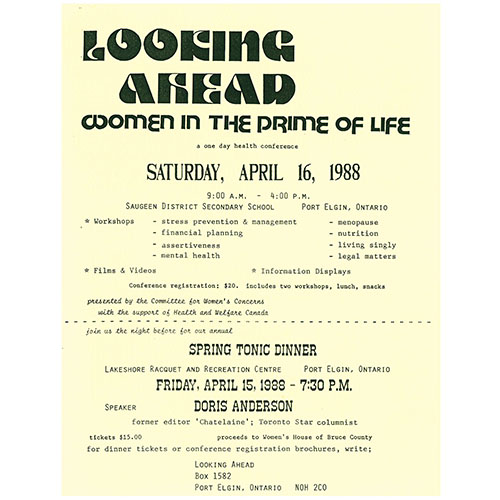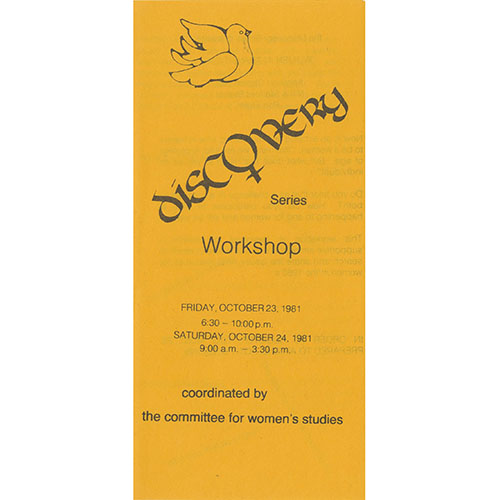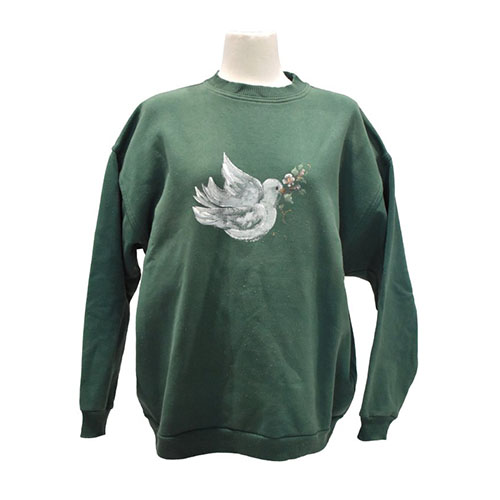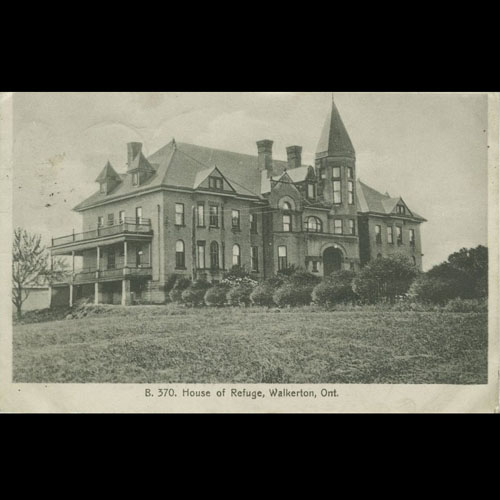Founding and Early Days
The founding of the Committee for Women’s Concerns (CWC)—initially called the Committee for Women’s Studies (CWS)—in the 1970s was shaped by a series of social and political influences. The Women’s Liberation Movement, or second wave feminism, of the late 1960s and 1970s had been encouraging the formation of unstructured groups who challenged the traditional idea of women as merely happy housewives and mothers. These groups vocally promoted women’s rights concerning the workplace, finances, health, education, family, and more.
Nationally, the movement prompted the establishment of the Royal Commission on the Status of Women in Canada in 1967 and the 1970 release of their revolutionary report containing 167 recommendations for legislation and key issues for women. Globally, 1975 was declared International Women’s Year and several women-focused programs were held.
Original members of the CWC first connected through their mother’s friendships, as well as through attendance and discussion at one of the International Women’s Year programs, a 1975 film series in Owen Sound called “Reel Women.” These original members included Anne Judd, Denise Grant, Colleen Thomey, Elizabeth Owen, and June Frost. Members bonded through their shared knowledge about the lack of opportunities for women and their own experiences interacting with women in their professional roles; one member was a nurse, while others worked in family planning counselling, the library, and at a newspaper.
The foundation for the CWC was further laid when Anne Judd applied to attend the Women in Transition series of conferences in Ottawa. Encouraging women throughout the country to attend, the Department of the Secretary of State had offered to cover costs associated with conference attendance so far as women would share their conference experiences and knowledge about women’s issues with their local communities. Anne successfully applied, indicating intentions to support women’s issues in Bruce County through speaking engagements and publications.
Following through with these intentions, the CWC members used their personal and professional knowledge to create the much-needed Bruce Women’s Directory to help women find resources concerning topics like legal rights, health, and gender bias at work. They had successfully secured funding to research, produce, print, and distribute the directory to all Bruce County households, as well as numerous independent businesses, government offices, schools and childcare centres, hospitals, legal offices, and more.
In November 1977, the CWC was formally established and continued to meet “as an unstructured group—no constitution, no officers other than a treasurer, no hierarchy—following a feminist model“ (Judd, “Recollections of the Committee for Women’s Concerns,” p. 1).

Growth Through Popular Events and Programming
After its formal establishment, the scope and awareness of the CWC continued to grow through network connections with other groups in neighbouring counties and the Department of the Secretary of State.
A series of CWC events and programming took off with the discussion surrounding the enforcement of the provincial Family Law Reform Act in 1978. This was the impetus for the CWC’s “Women and the Law” program. Featuring guest speaker and Toronto lawyer, Harriet Sachs, the program yielded significant attendance and led to the creation of the CWC’s popular Discovery Series of programming. In spring 1978, the CWC continued their Discovery Series with programs covering the themes of women and health, money, personal relationships, and work. According to Anne Judd, “[e]ach night, women responded with enthusiasm. In our town, we heard that some had left husbands to babysit while they went out. The coincidence of Bingo Night at the nearby Legion provided some with an acceptable reason” (Judd, “Recollections of the Committee for Women’s Concerns,” p. 2). The series continued in the following years and even expanded to include other workshops, education days, film screenings and discussions on topics like time management, and guest speakers, such as established female professionals.
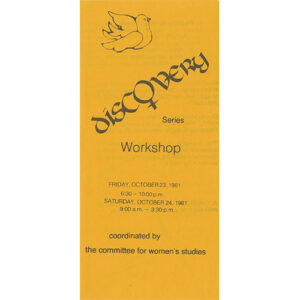
Throughout the years, as CWC programming expanded, so did its membership. New members included: Barbara Scollick, Yvonne Keenan, Stephanie Roddy, and Marsha Fleming. Beth Wolfe and Kristina Maus of the Concerned Farm Women, also in Bruce County, became part of the CWC network. Other CWC associates included: Pauline Aguire, Kay Nussey, Mary Taus, Lesley Weiler, and Mary Chatterton.
Additional programming comprised of networking and fundraising dinners, newsletters, fashion shows, parenting courses, and conferences. The CWC hosted annual Spring Tonic and International Women’s Day (March 8th) dinners up until 1989. These included either a visiting guest speaker or entertainment in the form of CWC skits.
In May 1981, CWC members also participated in The Rural Connection Conference presented by the Canadian Committee on Learning Opportunities for Women, in cooperation with the University of Western Ontario. Anne Judd participated as a panelist speaking about the formation of the CWC, while Barbra Scollick later joined Anne to host a workshop about forming a small-town independent women’s group.
After successfully applying for funding through the Health Promotion Contribution Program, on April 16, 1988, the CWC even hosted their own conference in Port Elgin called Looking Ahead: Women in the Prime of Life. Focusing on women’s health, the conference consisted of workshops on stress prevention and management, financial planning, assertiveness, mental health, menopause, nutrition, single living, and legal matters. Every single workshop was full and about 150 women attended the conference in total. The committee’s annual Spring Tonic Dinner was held the night before the conference and featured guest speaker, Doris Anderson, a women’s rights activist, former editor of Chatelaine magazine, and Toronto Star columnist. Speaking to a room of about 230 people, she touched on several topics—for instance, societal stereotypes of and attitudes toward women.
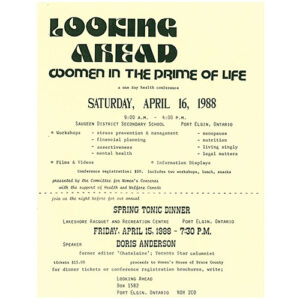
A Legacy
While the CWC dissolved in the early 1990s as opportunities for women were growing, the legacy of the committee continues. They supported the creation of the Women’s House of Bruce County (now, Women’s House Serving Bruce and Grey), a non-profit and charitable organization that functions as a temporary crisis shelter and family resource centre for women and children in need. Proceeds from the CWC’s 1988 Spring Tonic Dinner went to the Women’s House. Likewise, when the CWC dissolved, they “turned over remaining money to local women’s shelters” (Judd, “Recollections of the Committee for Women’s Concerns,” p. 2).
Reinforcing their goal of creating opportunities for women, the CWC also supported the creation of the Southport Chapter of the Canadian Federation of University Women (CFUW). Established in 1989 in Saugeen Shores, the CFUW Southport promotes women’s education, rights, and involvement in public affairs through programming and scholarships.
Today, the objectives of the CWC continue to be supported by the current work being done by both the Women’s House Serving Bruce and Grey and the CFUW Southport.
The records of the CWC also remain invaluable. Donated to the Archives at the Bruce County Museum & Cultural Centre, the records teach us lessons about women’s advocacy in Bruce from female perspectives. Likewise, with some of the issues they focused on still relevant today, their records serve as resources and inspiration for present and future women’s groups.



